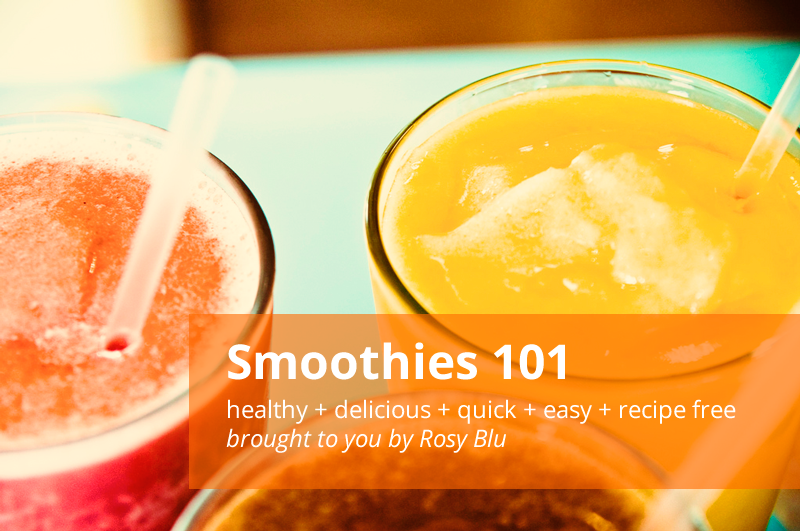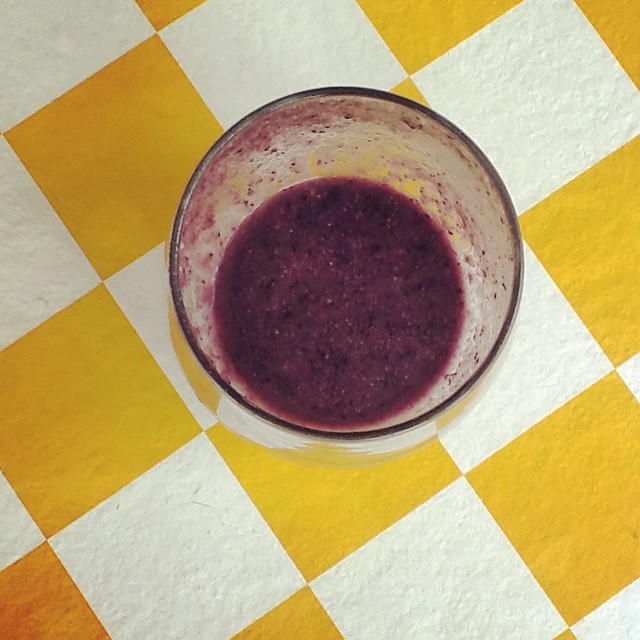Smoothies are everywhere, right? Since people started throwing veggies and greens in there, it’s turned into a health craze that everybody and their mother has tried.
There are a zillion and one recipes for smoothies…however, I find that recipes make me less pumped to make a smoothie. For whatever reason, a smoothie recipe generally makes me feel bored and limited and boxed in; I can’t explain it.
Today’s post will discuss my fly-by-the-seat-of-my-pants method of making smoothies—hopefully you’ll pick up a few helpful tips along the way.
In essence, what I’m doing here is applying some “cook without measuring” principles to the glorious creation that is a smoothie, in hopes that you will find it easier (and more delicious) to enjoy them yourself.

The basics
First, some general advice on my formula for a tasty smoothie. A well-rounded, tasty smoothie contains these things:
- Fruit (at least 50%)
- Veggies (50% or less)
- Liquid (enough for blending smooth, plus more to taste)
- Flavor enhancers & nutrition boosters (optional)
Fun fact: the first time I made a “green smoothie” I had no recipe, and packed it full of veggies—celery, cucumber, I think there was some broccoli, some kale, who knows what else. Lemon juice comes to mind. It was disgusting. I couldn’t get it down. Too many veggies, not enough fruit. This is why I recommend at least half of your smoothie be fruit. (Roughly. Like usual, I never measure these things.)
The method
We had a $30 blender when we got married that got us through a lot of years. It died of overuse (and because it was cheap) and we upgraded to this Oster one, which I love. It has a setting for frozen drinks, and varies from pulsing to low speed to high speed with one button.
If yours is more functional than fancy, I recommend starting with a few good pulses to get the pieces chopped a bit, then switch to high speed to whirl it all together. If you’re using greens, add them at the end (more on that later).
Sometimes I like to use my stick blender for smoothies (as long as I’m not using too many frozen ingredients or ice cubes) since it’s so easy to clean up when you mix it right in the glass.
The ingredients
Here’s a little more detail on each of the categories of ingredients:
Fruit
Anything goes, truly, but some blend better than others. Fresh or frozen works just fine, I like to use a blend of both, for variety of flavor, plus I don’t like my smoothies to be icy-cold. It hurts my teeth.
Bananas make a great base if you like a thicker smoothie. I use frozen peaches a lot, frozen mangos are awesome and berries of all kinds. I used fresh pineapple this morning and almost died from the deliciousness (see the image below for my “recipe”).
Vegetables
My personal favorite veggies to throw into smoothies include avocados (yummy and creamy! It’s nature’s butter after all), cucumbers (peeled or not, your call), and greens of all kinds.
If you’re using greens, add them at the end after you’ve blended everything else together. I’ll add a couple leaves of kale, a handful of spinach, chard or mixed greens, or a smaller handful of herbs if I have them in the fridge, like cilantro or parsley. The herbs add more flavor than plain old greens.
Is ginger a vegetable? I don’t really care whether it properly goes in this category, but I do like putting fresh ginger root in my smoothies. Cut off a knob that’s about 2cm or so (more or less, whatever you like) peel it, then chuck it in the blender. Ginger is good for digestion and detoxification, plus it’s tasty.
Liquid
The main purpose of the liquid is to make everything blend together more easily; exactly what kind you use is is up to wide interpretation. Water will do the job just fine. If you want the liquid to do double duty by also adding flavor and nutrients, you can use milk (or any substitute—almond milk, coconut milk or water, etc.) or juice (our favorite is orange).
I like to put my fruits and veggies in the blender first, then pour the liquid over everything until the chunks are mostly covered. When blending, I add more if it seems too thick to blend nicely, then at the end, I might add a little more if I’m feeling like a smooooooth smoothie that day.
Flavor enhancers
These are optional (sometimes I go without them completely) but they can enhance a smoothie-maker’s bag of tricks significantly by adding a flavor punch that might bring a smoothie from regular old smoothie up into the highest peaks of deliciousness.
Here are some of my favorites:
- Ginger root
- Vanilla extract
- Carob powder (adds chocolatey flavor & natural sweetness)
- Honey or maple syrup
- Spices (depending on the flavor combination, try cinnamon, cardamom, cloves or nutmeg. Start with a little; you can always add more.)
Moooore nutrition!
I’m not the greatest person to speak on the nutrition enhancers. I’m enthused about how healthy smoothies are, but as soon as somebody starts telling me why they’re so good, I say, “Oh! Cool!” then forget ALL the particulars. A few things have stuck with me, though, which I use a lot. Don’t ask me why they are nutritious, I just know they are.
- Flax seed meal
- Chia seeds
- A handful of raw cashews, peanut butter, any other nut butter or almond meal
- Greens bear repeating. They are so good for you, in so many ways, and blended up like that, you barely notice ’em.
- Avocados also bear repeating, because I love them in smoothies and they are a “super food.” Whatever that means.
And some tips.
Here are a few other random tips and ideas for your smoothies:
- Soak a handful of oats in about a cup of milk (or milk substitute) for an hour (or overnight), then use this as the base of a smoothie. The oats are good for thickening, and make a mean base for cake batter smoothie, one of my all-time favorites.
- Another classic combination is peanut butter + banana + chocolate (or carob). Tastes like dessert.
- Frozen mixed fruit is a great thing to have in the freezer so you can make smoothies anytime; I also like flash freezing bananas and other fruit before they get too ripe, then I use them for smoothies.
- Freeze leftover yogurt (regular or Greek) in ice cube trays for future use in smoothies. You can even package it with fruit for little smoothie kits.
- If you inevitably make too much smoothie (like me, always), you can freeze leftovers in reusable Popsicle containers (I have some awesome ones of the push-pop variety) for a yummy frozen treat to be enjoyed at a later date.
- A beautiful/fancy glass makes it taste better. I’m not kidding. Try a smoothie in a martini glass and tell me you don’t feel chic.
I could go on, but I think you’ve learned enough now to go make something DELICIOUS + NUTRITIOUS. Go forth, and make smoothies.

What’s your favorite flavor combination for smoothies? Tell us in the comments!
// First smoothie image (modified) by Ken Hawkins on Flickr, used with permission